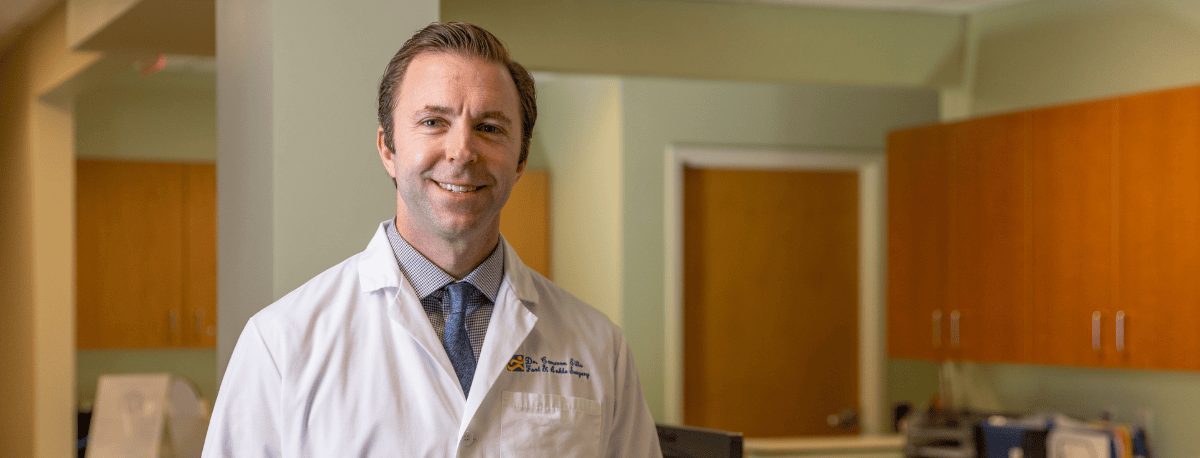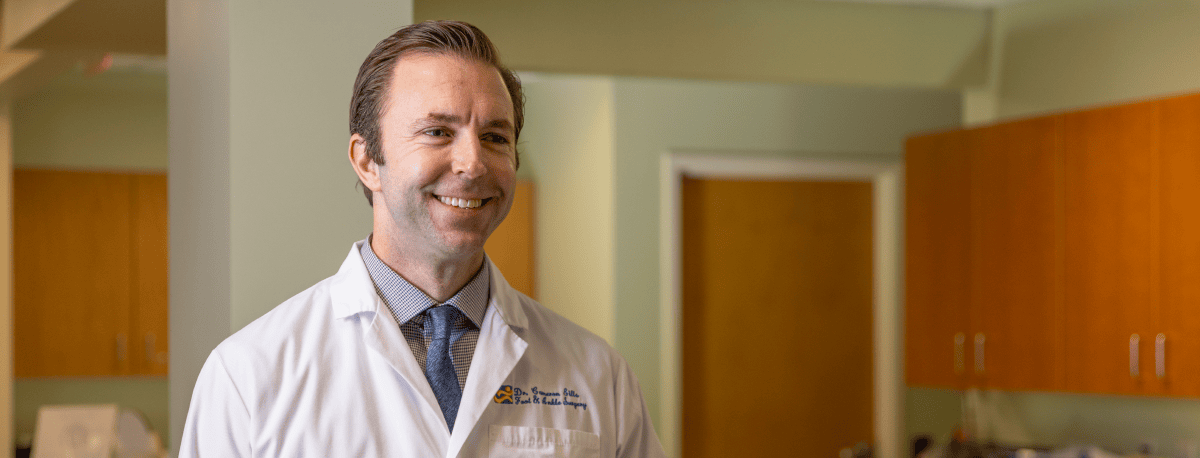We all know the feeling of foot pain after a long day on your feet, a weekend of yardwork, or a strenuous workout or sporting event. But what happens when that discomfort doesn’t go away and starts to interfere with your daily life? That’s when it may be time to get checked out by a specialist.
At Atlantic Orthopaedics & Sports Medicine, Dr. Cameron Eilts has been helping patients find relief from foot and ankle pain since 2011. Whether it’s a sprained ankle, complications from diabetes, or chronic heel pain, Dr. Eilts focuses on understanding each patient’s unique needs and finding the right treatment—surgical or not—to relieve the pain and get them moving again.
Common Causes of Foot & Ankle Pain
Foot and ankle pain can come from many sources. Some of the most common include:
Plantar Fasciitis
Symptoms: A sharp, stabbing pain in the heel that’s often worst in the morning.
Cause: strain or small tears in the plantar fascia, a thick band of tissue along the bottom of the foot, often due to overuse, poor arch support, or tight calf muscles.
Arthritis
Symptoms: Stiffness, swelling, and discomfort in the joints of the foot or ankle.
Cause: Results from wear and tear (osteoarthritis), autoimmune conditions (like rheumatoid arthritis), or post-injury degeneration that leads to joint inflammation and cartilage breakdown.
Tendonitis
Symptoms: Pain due to inflammation of the tendons.
Cause: Typically caused by repetitive stress or sudden increases in activity, leading to inflammation of tendons that connect muscle to bone.
Ankle Sprains
Symptoms: Ankle pain due to overstretched or torn ligaments.
Cause: Often a result of sudden twisting, rolling, or impact during sports or uneven walking.
Diabetic Foot Issues
Symptoms: Include nerve damage and reduced blood flow that can lead to infection, ulcers, and decreased healing ability.
Cause: Stems from long-term high blood sugar
While these conditions vary widely, the goal is always the same: relieve pain, restore function, and prevent further damage.
Not All Foot & Ankle Issues Require Surgery
One of the most common misconceptions about seeing an orthopedic specialist is the fear that surgery is the only option. Dr. Eilts emphasizes a conservative approach to treatment whenever possible. Many patients find non-surgical relief through physical therapy, injections to reduce inflammation, or bracing to immobilize and protect the area so it can heal.
When It Might Be Time to Consider Surgery
Of course, not all pain can be resolved non-surgically. If conservative treatments haven’t worked, or if your condition is worsening, surgical intervention might be the best path forward. Here are a few signs that it’s time to see a foot and ankle specialist like Dr. Eilts:
- Chronic pain that doesn’t improve with rest or conservative care
- Recurrent sprains or instability in the ankle
- Numbness, tingling, or visible deformities
- Limited mobility affecting your quality of life
Dr. Eilts takes the time to evaluate each case individually, using a physical exam and advanced imaging and diagnostics, to create a treatment plan tailored to your specific condition and lifestyle. If surgery is needed, he will walk you through every step of the process, from pre-op preparation to post-op rehab.
Don’t Wait on the Pain
The longer foot and ankle pain goes untreated, the harder it can be to fix. Trying to “tough it out” can sometimes do more harm than good. Whether you’re dealing with nagging heel pain, recurring ankle sprains, or diabetic foot concerns, Dr. Eilts and the team at Atlantic Orthopaedics are here to help. With a focus on personalized care and a full range of treatment options, we’re ready to set you on the path to recovery–so you can get back to doing the things you love as soon as possible.
If you’re suffering from foot or ankle pain, don’t wait it out. Get in touch to schedule an appointment with Dr. Eilts today.


